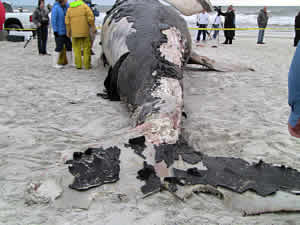
NOAA Fisheries Scientist Barb Zoodsma joins stranding network partners to examine the dead right whale. Credit NOAA
The death of a young right whale off Florida drives home the point that while disentanglement responses give the animals a better chance at survival, prevention of entanglements in fishing gear is paramount.
On February 3, NOAA scientist Barb Zoodsma joined partners from numerous state and local agencies, along with researchers from academic institutions and nonprofits organizations, to perform a necropsy â€" animal autopsy â€" on a young right whale. The animal was observed floating dead off St Augustine, FL, by an aerial survey team from Florida Fish and Wildlife Conservation Commission two days earlier, and was towed to shore for examination.
Scientists were already familiar with this animal. First sighted entangled with fishing rope on Christmas Day, this two-year old female whale had been the focus of much attention since the new year. In two separate disentanglement attempts December 30, 2010 and January 15, 2011, more than 200 feet of rope had been removed from this critically entangled species. Unfortunately, as scientists would learn, these unprecedented response efforts were not enough to save its life.
Led by necropsy team leader, William McLellan of University of North Carolina Wilmington, and assisted by Dr. Michael Moore, Woods Hole Oceanographic Institution, and Alex Costidis, University of Florida, scientists examined this 31 foot, 15,000 pound whale for clues to its demise. Numerous lesions from its long term entanglement and shark bites were examined thoroughly, and tissue samples from the wounds will be shipped to labs for further study. The final results of the necropsy will depend on these analyses and will not be available for some time.
Initial observations lead researchers to conclude this whale had been entangled for months. Parts of the rope that could not be removed during the disentanglement efforts were found to be embedded in the whale's mouth, possibly impeding it from feeding. The young female was significantly underweight. Weakened and injured by the long entanglement, she was easier prey for sharks. Bite marks on the carcass suggest that scavenging sharks may have finished off the wounded whale by severing major veins at the base of the tail.
The rope removed from the whale was floating groundline from a trap/pot fishery. NOAA Fisheries Service has prohibited floating groundline in U.S. Atlantic coast trap/pot fisheries managed under the Atlantic Large Whale Take Reduction Plan to try to reduce these lethal entanglements, but it is still used in some international fisheries.
The necropsy was a multi-organizational effort, with experts hailing from several states. NOAA necropsy partners include: Florida Fish and Wildlife Conservation Commission, Georgia Aquarium Dolphin Conservation Field Station, Georgia Department of Natural Resources, Hubbs Sea World, St John's County, University of Florida, University of North Florida, University of North Carolina at Wilmington, Woods Hole Oceanographic Institution, and the Virginia Aquarium.
With only 300-400 in existence, North Atlantic right whales are among the most endangered whales in the world. They are protected under the U.S. Endangered Species Act of 1973 and the Marine Mammal Protection Act of 1972. Vessel strikes and entanglement in fixed fishing gear are the two greatest threats to their recovery.
NOAA Fisheries Service encourages people to report sightings of dead, injured, or entangled whales to the Florida Fish and Wildlife Conservation Commission at 1-888-404-FWCC (3922) or the Georgia Department of Natural Resources at 1-800-2-SAVE-ME (272-8366). All live right whale sightings should be reported to the USCG via Channel 16.
